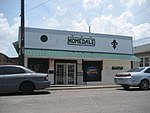City Park Practice Track
1992 establishments in LouisianaAthletics (track and field) venues in New OrleansRugby union stadiums in New OrleansSports venues completed in 1992

The City Park Practice Track or City Park Track is a 400-meter polyurethane track located in City Park in New Orleans. It was originally built as the practice/auxiliary track for the 1992 U.S. Olympic Track & Field Trials for the 1992 Summer Olympics. The track which is located adjacent to Tad Gormley Stadium, was renovated in 2006.It is home to the Jesuit Blue Jays, 2021 XC state champions, and the University of New Orleans. The facility is also used during track and field meets held at Tad Gormley Stadium. The track is the finish line for the Crescent City Fall Classic road race. It is also the practice facility for the New Orleans Halfmoons rugby club.
Excerpt from the Wikipedia article City Park Practice Track (License: CC BY-SA 3.0, Authors, Images).City Park Practice Track
Franklin D. Roosevelt Mall, New Orleans
Geographical coordinates (GPS) Address Nearby Places Show on map
Geographical coordinates (GPS)
| Latitude | Longitude |
|---|---|
| N 29.989444444444 ° | E -90.099444444444 ° |
Address
Tad Gormley Stadium
Franklin D. Roosevelt Mall
70119 New Orleans
Louisiana, United States
Open on Google Maps










